EBOOK
The Secrets of Social Commerce
Published: Oct 10, 2019
Everything E-commerce Brands Need to Know About Driving Sales from Social Media
First there was e-commerce, then m-commerce, now s-commerce (or social commerce). As e-commerce continues to develop at a pace, new ways to sell are emerging on a regular basis. Keeping on top of the social media channels that deserve your attention can be a challenge. Though social commerce has grown pretty slowly (and faced a few challenges along the way) the coming together of social media and e-commerce is no longer a pipe-dream, seemingly have become a reality overnight.
Back in 2018, Mary Meeker’s Internet Trends reported that social commerce was finally gaining traction, particularly among 18-34 year olds. In 2019, it has truly arrived. In this ebook we are going to unpack everything you need to know about social commerce to help you decide if an s-commerce strategy is right for your brand.
What is Social Commerce?
Before we jump in, let’s first take a moment to define what we mean by social commerce, or s-commerce. The simple answer: social commerce is e-commerce as seen through the lens of social media. It’s the shopping experience framed so that the beginning of the journey – and very often the end of the journey too – takes place within a social media application.
This can manifest itself in different ways, but the end goal of social commerce is to create a streamlined user experience that makes it as simple as possible for social media users to purchase products during their regular use of social media apps such as Facebook, Instagram and Snapchat. Incorporating a social commerce strategy into your business doesn’t just allow for another means by which you can sell your product – it also offers new opportunities for reaching an audience and creating a customer journey that suits their needs.
Why use Social Commerce?
So far, so good. But if social commerce is only taking off now, do you really need to get a strategy in place? Let’s take a look at some numbers.
As of 2019, social media still only accounts for about 9% of all referrals to e-commerce sites – but this won’t be the case for long. In two years this rate has grown by 110% – faster than any other form of referral. This rate of growth has caused many to sit up and take note, with adoption among US retailers doubling between 2017 and 2018:
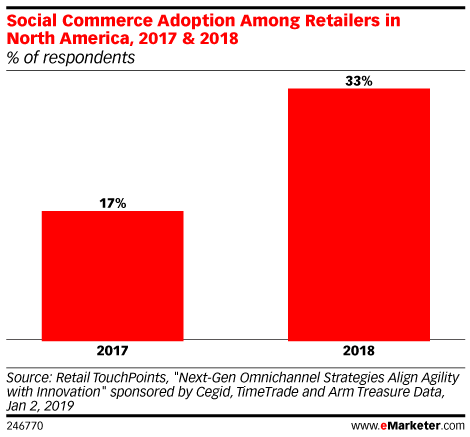
So, as we can see by the growth in referral traffic, consumers are certainly using social commerce to discover products they’re interested in, but what about actually buying them? In 2018, 55% of consumers reported buying something after discovering it via social media, with 44% buying immediately, and 11% purchasing the item at a later date.
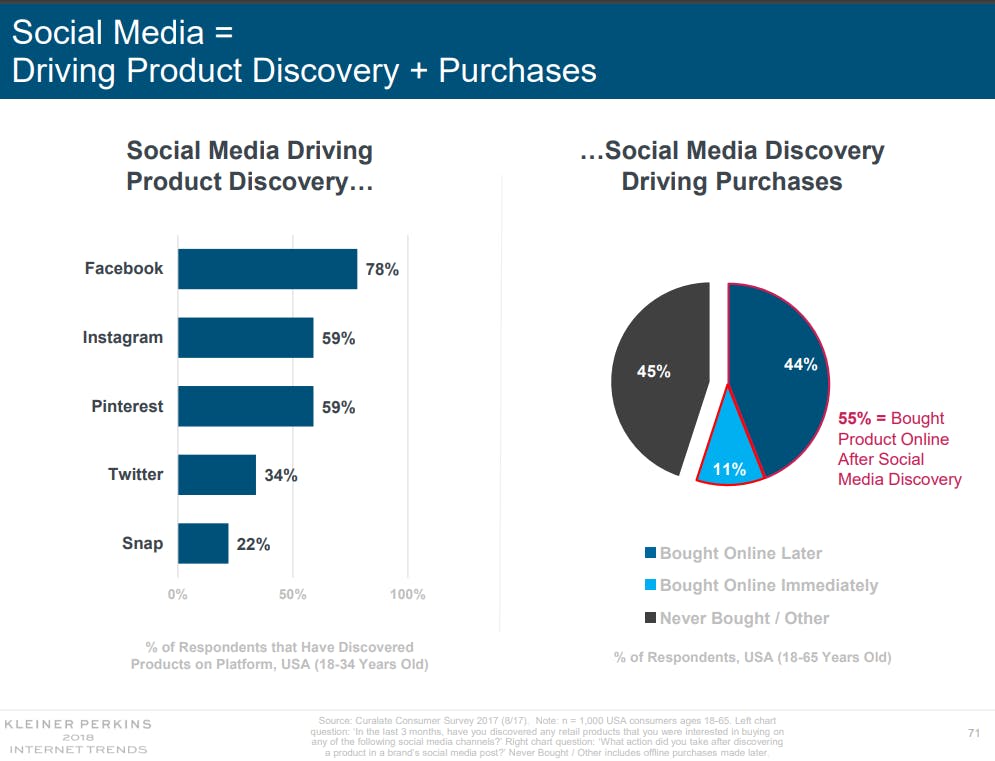
These figures will continue to grow as both social media platforms and businesses better understand what audiences are looking for from their social media e-commerce. Increasingly, it looks like enabling consumers to buy natively within their favorite social media platforms is the direction we’re headed, so let’s take a look at what’s already on offer…
Where can I see Social Commerce in action?
At this point, you can find active examples of social commerce on almost every social media platform you can think of. This doesn’t mean that all platforms or equally worthy of your attention, though. Whilst e-commerce in general has experienced an upward trend year on year more or less since it first came about in the 1990s, social commerce has faltered here and there.
This is because it’s taken a while for both retailers and social media businesses alike to understand how users want to interact with their social media commerce opportunities. But whilst ecommerce business need to look at how customers’ needs are unique in their industry, social commerce also requires at least a rudimentary understanding of how customers’ needs and desires change depending on which social media platform they are using. Even the social media businesses themselves have struggled to work this out on occasion – Twitter, notably, has actually said good-buy to it’s biggest social commerce function, the ‘buy’ button.
Whilst social commerce can be found across any number of websites and apps, we’re going to take a look at the big four. These are the social media businesses that have best worked out how to utilize their platforms to become the most popular social e-commerce sites around.
In many ways, Facebook is the original s-commerce king. Whilst other massive social networks like MySpace had come before, Facebook was the first to really look into the benefits of combining social media with e-commerce. This relatively long history in social commerce means that Facebook has perhaps the clearest understanding of the form, and is best positioned to create the tools that will best help businesses and consumers alike. It also has an unparalleled audience reach – over 2.3 billion active monthly users.
Even though its reputation as the most relevant social media business has long since slipped, Facebook’s huge user base and progressive s-commerce policies mean it’s still top of the pile for e-commerce. CEO Mark Zuckerberg has spoken of his disinterest in the unnecessary monetization of Facebook’s social commerce, saying that an open and accessible format that doesn’t charge retailers to do business on the platform will ultimately encourage them to spend more on Facebook’s advertising services.
“We’re going to build more tools for people to buy things directly through the platform. As those products that we build help businesses convert better, [Facebook] will be more valuable to them, and therefore that will translate into higher bids on advertising.”
Mark Zuckerberg, CEO, Facebook speaking during the company’s Q1 2019 earnings call
The tools Facebook are implementing are varied, but include the ability for customers to directly contact retailers through Facebook’s messaging app, and expanded payment methods through this same channel. The video advertising opportunities are hard to ignore too, offering businesses the chance to feature targeted ads before user-uploaded videos on one of the biggest websites on the planet.
Instagram is another big winner in the field. This is for two reasons: firstly, it’s a visual format, which lends itself to sales. Adverts are integrated seamlessly into both the user’s image feed and the short-term ‘Stories’ feature. Those businesses that can best take advantage of the format – using eye-grabbing visuals that fit the aesthetics of the app and don’t feel overtly like ‘adverts’ stand to win big.
This is in no small part due to Instagram’s other big benefit – it is owned by Facebook, and is being given as much, if not more, social commerce attention than Facebook. This means the tools at hand to help businesses sell are amongst the best available, and that new features are frequently being released.
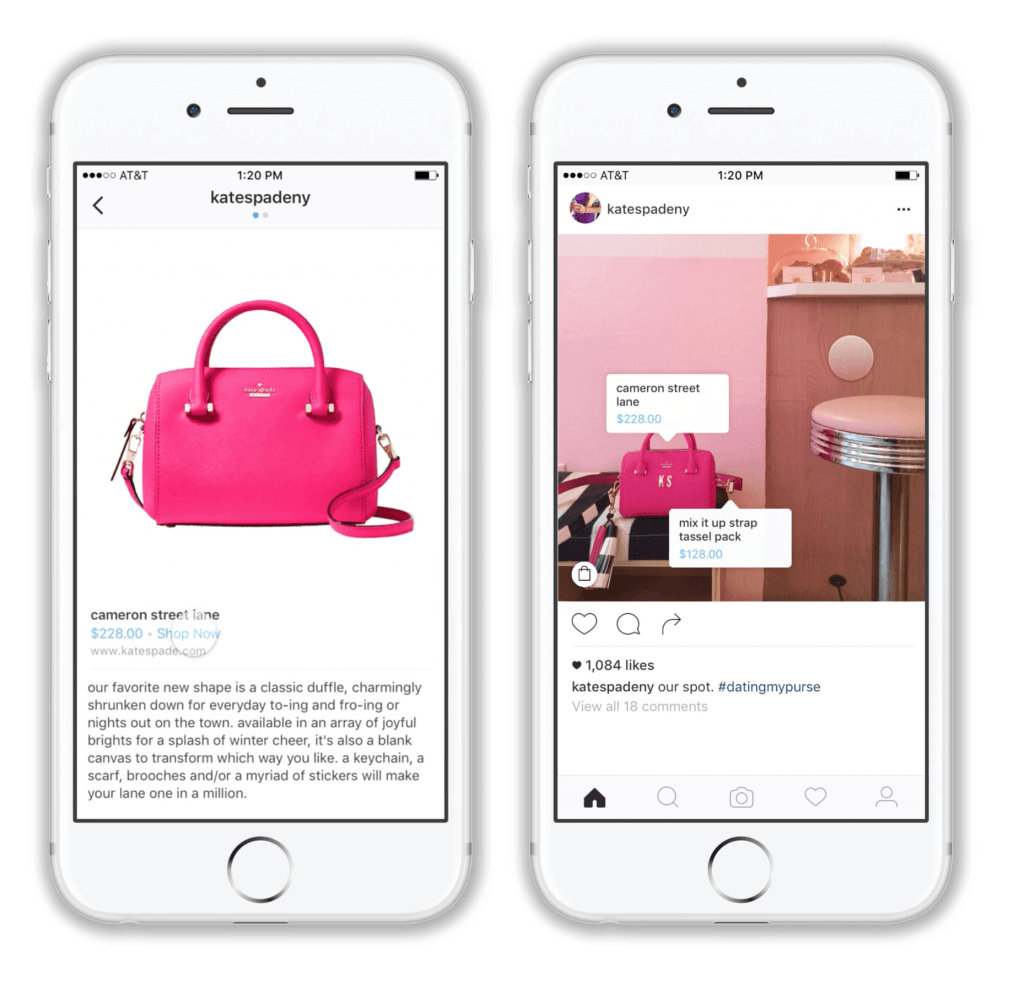
The ‘Shopping on Instagram‘ feature allows for products in a photo to be tagged, and this years big game-changer, Instagram Checkout, allows for the entire customer journey to be completed within the app. As this is rolled out beyond initial beta partners, Instagram will become the s-commerce platform to beat.
A bigger player among the social e-commerce platforms than it is perhaps amongst social media more generally, Pinterest’s importance might be a surprise. Like Instagram, though, the website is heavy on aspirational visuals. Its audience is skewed heavily towards a female user base, and will suit certain businesses more than others. Those looking to sell products that fit Pinterest’s interests (home furnishings, cookware, clothing and other beautiful things!) are able to create ‘shoppable pins’ that users can both save onto their own boards for later, or use for immediate in-app purchases.
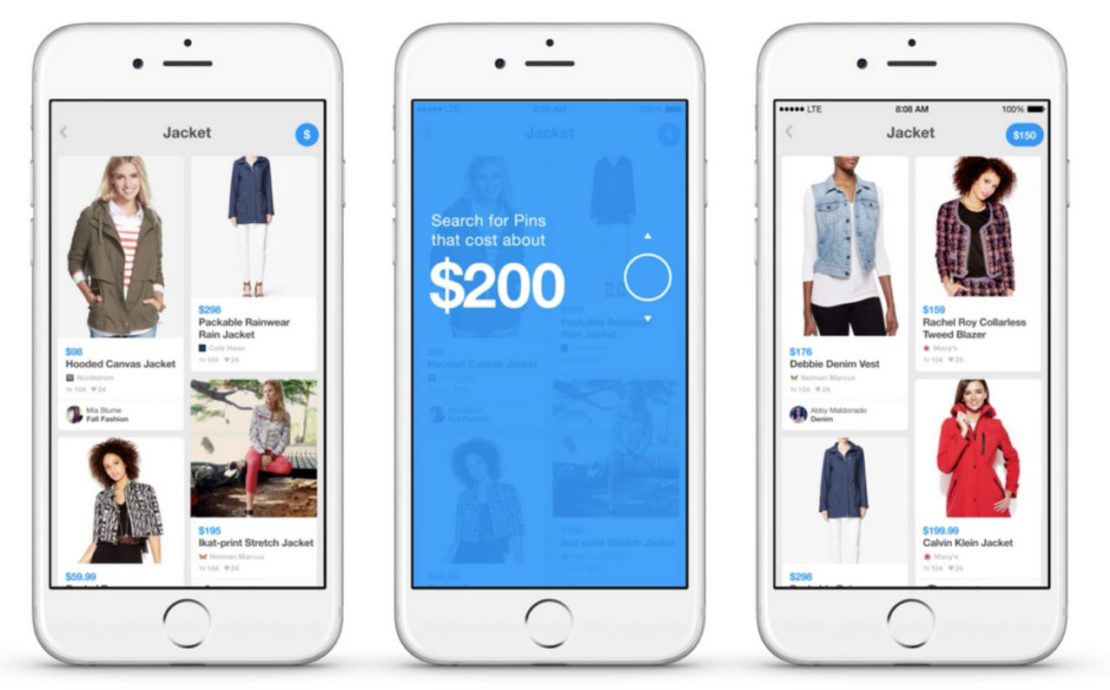
Pinterest’s real benefit for retailers is that, more than any other social media platform, it is used specifically by people who are interested in buying things. People go to Facebook to catch up with friends, and to Instagram for aspirational holiday photos. Pinterest, though, is where people go when they want to imagine buying new products.
“Pinterest is where we see a highly engaged user who’s actively searching for inspiration to purchase from Hunter”
Alasdhair Willis, Creative Director, Hunter Boots
Features include the ability for businesses to upload their entire catalogue as ‘shoppable pins’ as well as new developments in targeted, personalized recommendations. In September 2019, Pinterest announced a ‘shop the look’ feature, which will allow pins to be tagged with up to 25 different items that can be purchased.
Snapchat
When Twitter deemed its experiment with the ‘Buy’ button a failure, and ceased its support for the feature, there were two arguments for why it hadn’t been a success. Some said that Twitter was simply a giant on its way out, and the lack of interest in social commerce on the site was due to a decreasing level of interest in the site itself. Others claimed it was evidence users weren’t as interested in social media e-commerce as hoped. Snapchat suggests both of these are wrong.
Since adopting a stronger social commerce strategy, Snapchat has actually stemmed its declining user base and improved revenues significantly. It’s the perfect example of finding what a specific social media user base wants, and catering to it.
Where Instagram and Pinterest are aspirational sellers, Snapchat has positioned itself more practically. By teaming up with Amazon, users have been able to snap photos of items they’d like, and find them for sale with the retailer. Adverts on the app have been made shoppable too – users don’t need to click through to an external page, and can buy natively without leaving the app.
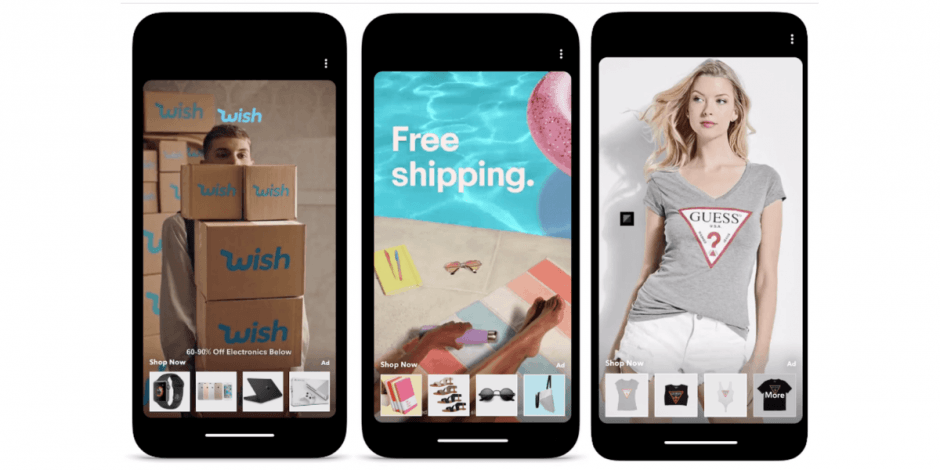
E-commerce brands leveraging Social Commerce
So, now we’re more familiar with what’s on offer from the platforms, which brands are using social media to sell?
At the forefront, we have the larger brands who have the cachet and the scale to be included in the beta testing of new social commerce features, such as Instagram Checkout (currently available to less than 30 brands). While brands like Zara and Burberry have been able to try out this new feature since March 2019 – the real results won’t be known until it’s rolled out to a wider range of brands. So let’s take a look at one of the features that is more widely available – Instagram Shopping.
Instagram shopping is available pretty much globally (44 countries to be exact), and the results are rolling in. E-commerce platform BigCommerce actually followed up with those stores lucky enough to get in on the beta to understand the kind of results Instagram shopping is driving, and the outlook is positive, with brands big and small seeing sizeable increases in traffic and revenue.
Barbour is one example of a brand that has seen great results from Instagram Shopping. If you’re on mobile you can click through on the post below to see it in action!
As Laura Dover, Global Communication Director at the brand told Instagram:
“Since we started to use the feature, our sales from Instagram have increased by 42% and traffic to our website from Instagram is up 98%”
But what if you’re just starting out, or don’t have access to trials of new features? One of the easiest ways to get started with social commerce is via ads. Again, it’s important to think about the audience on each platform, and the mindset they are in! For example, Instagram ads are well suited to travel companies like Jack’s Flight Club or Easyjet, as they can take advantage of a user base who are frequently being exposed to visuals of stunning international locations. Similarly, Pinterest ads can be used to highlight homewares to users who have been looking at gorgeous kitchens and immaculately designed bedrooms.
Another approach is to take advantage of influencers and nano-influencers – people whose tastes inform those of their followers, which can number anywhere from a few thousand to tens of millions. Influencers can be offered sponsored collaborations, like the one Shackleton Whiskey offered user @arranwitheford – a travel photographer with 64,000 Instagram followers. The photos in his sponsored post start much the same as his usual entries – gorgeous landscapes that are unrelated to the sponsor. But users are drawn in through these images to the warming, cosy shots of branded whiskey.
A more organic way to create content is to get your customers to make it for you. Subscription box companies such as Mindful Chef, Loot Crate and Birchbox deliver their products to consumers in beautifully designed packages that encourage photo-sharing via social media. With every delivery, social media users fill their feeds with custom-made content that their followers will see and, hopefully, be tempted by.
How to benefit from Social Commerce?
It’s increasingly easy to combine social media and e-commerce to benefit your business. In fact, social commerce is flexible enough to offer multiple opportunities to grow and develop your business along the customer journey, through the different stages of acquisition, conversion and even customer retention.
The power of social media lies in the fact that it can play a key role across all stages of the customer journey – the catch is that it requires a considered approach. People need to hear different things from a brand depending on which stage of the customer journey they’re currently at.
Callum McCahon, Strategy Director, Born Social
Acquisition
Acquisition is the area that companies are most inclined to use social media and social commerce for currently. There’s no doubt that the large audiences offered by the likes of Facebook are a huge temptation for any company looking to expand their customer base.
We’ve already seen a couple of ways companies can introduce people to their brand above – influencers are an excellent voice for sharing new ideas on a large scale. Well-placed adverts are another way to put yourself in front of new eyes for the first time, too.
The key is to present a clear vision of who you are as a brand, and what your company does. For Callum McCahon, Strategy Director at social media agency Born Social this means creating an emotional connection:
“At the awareness stage, it’s about identifying new potential customers and introducing them to your brand. We advise going as broad as possible with your targeting – that’s how you build a brand over the long term. This is your longer term brand building work and it requires communicating on an emotional level with your audience. “
“On social, this requires distilling your message right down – you need a single minded proposition and you need to communicate that with absolute clarity. Show people something interesting. Don’t get dragged down in sales messaging or a clear call to action at this stage – it’s about making a powerful first impression and making your audience feel something.“
Though we’ve already seen how different social media platforms have different uses and audiences, it’s still important that your cross-platform presence is consistent in both voice and style. Draw your audience in with effective visuals – particularly on platforms heavy on that medium, like Instagram, Pinterest and Snapchat.
If your aim is to encourage new customers to click through to your website, make sure that once they arrive at the website their customer journey is a relevant one. One way to do this is to personalize the website via referral source targeting to present specific content to users depending on where they have arrived from.
For example, Simply Cook, showed a notification to customers arriving from Facebook from a particular offer on Facebook. This allowed for a smooth customer experience, and increased the likelihood of a new customer engaging with the website. Not only that, but it helped ensure that acquisition budget was not wasted, as it asked those visitors for their email address in exchange for a discount, yet another reason to convert.

This campaign alone generated over 7,000 new leads for Simply Cook, and opens to door to delivering personalised offers to other visitor segments arriving on site from different traffic sources, for example, those arriving from vegetarian or gluten-free content on Facebook.
Conversion
Social media and social commerce also offers opportunities to raise conversions on your site, by utilising social posts to encourage customers to make a purchase via the power of social proof. Bathroom retailer soak.com encourages Instagram users to share their home bathroom decor with the hashtag ‘#mysoakstyle’, and features Instagram posts on their website alongside opportunities to ‘shop the look’.
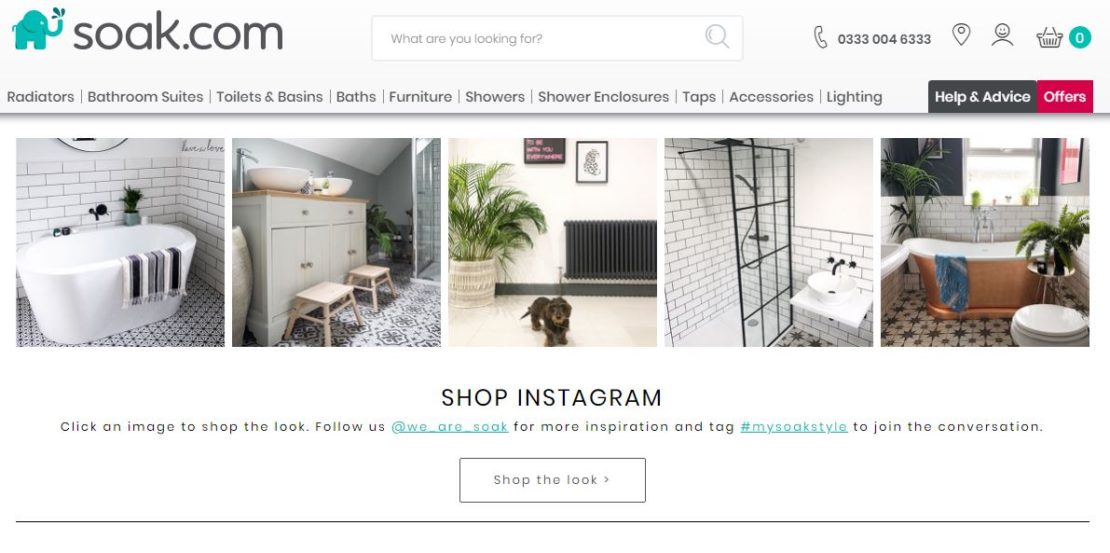
Including other users’ experiences, as framed through social media, is an excellent way to provide social proof. By showing customers that other people are already buying these products or using these services, it’s possible to instil a sense of belief that they are worth buying. This can be done in any number of ways, including live updates that highlight trending products on social. Alternatively, the simple featuring of reviews from sites like Facebook can allow customers to develop trust for a business, seeing the success others have had in their experiences.
Your social channels themselves are a powerful extension of your website and can be used to push followers and fans who are more ready to buy further down the funnel, toward conversion. Callum McCahon, Strategy Director at social media agency Born Social explains:
“We see social as a really powerful conversion tool, giving people the nudge they need to convert. At this stage, it’s about communicating a clear, rational message. This is where you can explore personalization, making sure what you’re communicating is relevant to what the user needs to hear in order to convert.
This is the time for a clear call to action – make that desired action obvious and frictionless. Remember that most people scroll through social at lightning pace, so don’t be afraid to push the frequency here – people often need to see a piece of content 2-3 times before they take the desired action. “
Customer Retention
Once you’ve made a sale, social media offers a range of ways to both retain the customer and involve them actively in spreading the word to more potential buyers. One key way to do this is to involve your social media when promoting any loyalty program you might have.
This might involve simple promotion via your channels, as beauty eCommerce retailer Feelunique does on its Instagram feed. By sharing a tempting offer in a bright, simple image, Feelunique grabs the users attention. The full loyalty program is spelled out in a little more detail in the caption, and their bio leads to a custom page featuring all recent Instagram activity, and shoppable or relevant links for each post.
Companies can also promote special offers for loyalty scheme members enabled through a call to action that could include sharing social media tags or posts, or signing up to social media channels. Increasingly, companies are using social media platforms like Facebook to enable log-ins on their website, linking social commerce and e-commerce more closely.
Social Commerce: In Conclusion
However you plan to involve social commerce with your business, you’ll find there are huge opportunities for growth, conversion and customer retention. Remember to think about how the audiences on each social media channel differ, whilst aiming to keep a sense of consistency in your messaging regardless of where it’s being seen. With thought and relevant content, you’ll be well on your way to receiving the many benefits social commerce offers!